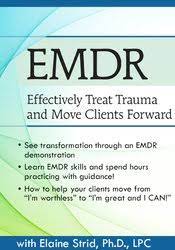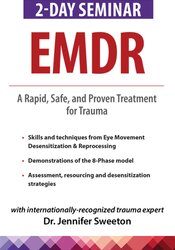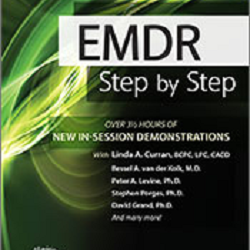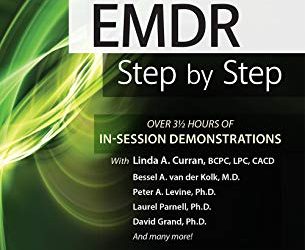🌟 New Year Offer 🌟
Celebrate 2025 with 30% OFF on all products! Use code: NEWYEAR2025. Hurry, offer ends soon!
In this unique EMDR workshop, you will understand the benefit of EMDR and the impact it can have on your clinical work. You will also learn the 8 Stages of EMDR Therapy and have more than three hours of practice time with some the foundational EMDR skills.
Elaine Strid – EMDR. Effectively Treat Trauma and Move Clients Forward

EMDR: Effectively Treat Trauma and Move Clients Forward – Elaine Strid
- See transformation through an EMDR demonstration
- Learn EMDR skills and spend hours practicing with guidance!
- How to help your clients move from -I’m worthless to -I’m great and I CAN!
If you’ve heard of EMDR (Eye Movement Desensitization and Reprocessing), you know it works to heal trauma and you want to know more, this workshop is for you! Attend this unique workshop and learn essential information you need to know about EMDR.
Dr. Elaine Strid, EMDR-Trained Therapist, will first teach you about EMDR and the neurobiology of how EMDR can change the brain. Then she will do a complete live demonstration so you can see EMDR in action!
In this unique EMDR workshop, you will understand the benefit of EMDR and the impact it can have on your clinical work. You will also learn the 8 Stages of EMDR Therapy and have more than three hours of practice time with some the foundational EMDR skills.
Dr. Strid hears often from fellow trauma clinicians that they do a great job working with clients to cope better with trauma; however, clients claim that they feel -filthy and powerless about themselves. Elaine will show you how EMDR can help clients move forward to truly heal from the inside out and how to live a fulfilling life again.
- Evaluate the biological nature of trauma; how trauma is stored in the brain and limbic system, creating physical and psychological symptoms.
- Determine the purpose and practice of EMDR for the treatment of trauma.
- Analyze the neurobiology of how EMDR works relating to trauma treatment.
- Determine effective techniques to reduce/eliminate client’s body memories, -flashbacks’ and dissociation.
- Simulate via a demonstration how to use EMDR for trauma.
- Analyze Shapiro’s 8-Phase Model of EMDR as it relates to treatment.
- Evaluate potential in-session barriers to EMDR progress and identify strategies to mitigate them.
- Develop EMDR-focused psychoeducational materials to share with your clients.
- Teach your clients to use EMDR informed strategies when triggered in public and in relationships.
- Incorporate meridian-based techniques to decrease arousal levels and modulate affect with traumatized clients.
- Evaluate the research behind using EMDR in combination with other modalities such as CBT and mindfulness and the clinical effectiveness for clients.
- Reinforce when it is appropriate to use EMDR techniques to use when triggered in session with your clients and/or yourself.
Get immediately download Elaine Strid – EMDR. Effectively Treat Trauma and Move Clients Forward
EMDR & How it Changes the Brain
- Definition: Origin from Francine Shapiro
- Purpose in resolution of trauma
- How EMDR rewires the brain
- Neurobiology
EMDR 8 Stages Protocol and More
- Get the client ready for EMDR
- Identify and explain the 8 Stages
- How to handle dissociation
- Checking the safety in the safe place
- SUDs (Subjective Units of Distress)
- Negative and positive cognition
- Installing the positive
- Using body scans
- Being very present and aware of your client
- Re-evaluation
- What to do when things aren’t working well
EMDR Techniques for You and Your Clients
- Safe place techniques for clients outside of therapy
- EMDR when flashbacks happen
- Butterfly hug
- Hot water bath
- Self-tapping
- Foot in shoe tapping
- Breathing out the bad, In with the good
Teaching EMDR Techniques to Clients
- Entry level – benefits to develop safety to use in session
- Add to the client’s toolbox while trauma resolution is occurring
- Develop the client into 3 confidence levels using EMDR techniques:
- Safety with self
- Safety with others they are close to
- Safety with strangers & general safety in public
Importance of Positive EMDR/Positive Cognition Reinforcement
- Practice counselor confidence with EMDR
- Find where the deficits are
- Build self-control, confidence and character traits in your clients
- Help clients develop skills in maturity in relationships
- Help them become more self-aware
- Somatization awareness
- Emotional shutdowns
- Inability to bond
- Build self-value in clients
- Bonding/attachment skills
- Confidence in goal setting
- Capabilities to say no/yes to their dreams
How to Pair EMDR with Other Therapies
- Research base for using EMDR with other therapy techniques
- CBT
- Mindfulness
- Gestalt
- Pet/Equine
EMDR in Action- Practice Throughout Both Days
- Watch a transformation via an EMDR demonstration
- Practice with questions and body scanning
- Practice of positive cognition and new brain traits
- Use EMDR in fear situations
- EMDR for confidence building
- Restore Self from Compassion Fatigue for yourself
Where to Go from Here?
- EMDRIA Certification guidelines and information
- More intensive EMDR trainings
- Other EMDR resources
Course Features
- Lecture 0
- Quiz 0
- Duration 10 weeks
- Skill level All levels
- Language English
- Students 118
- Assessments Yes





